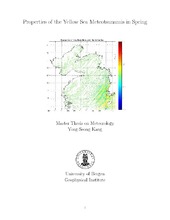| dc.description.abstract | This paper documents the properties of the Yellow Sea meteotsunamis in spring based on a total num- ber of 49 meteotsunami events in spring (Mar-May) between 2002 and 2013 documented by the Korea Meteorological Administration (KMA). The typical synoptic setting for the meteotsunami events is that an intense positive relative vorticity max forms over Manchuria, which is triggered by the development of the jet stream from the north- west. The relative vorticity max generates atmospheric disturbances over the Yellow Sea, which move at a favourable speed, about 26 m/s, for the Proudman resonance. There are two different patterns in atmospheric disturbance movement, approaching from the north-west and the south-west, which are associated with the evolving atmosphere to the most favourable synoptic setting for a meteotsunami in the Yellow Sea. In general, the SW pattern occurs during times in transit to and from the typical setting, whereas the NW pattern takes place more likely at the mature typical setting. During the evolution of the typical synoptic setting, the vorticity max generates disturbances consecutively for a couple of days, which is attributed to the high frequency of occurrence of meteotsunami in the Yellow Sea in spring. Mean properties of the Yellow Sea meteotsunamis in spring can be expressed as: a mean atmospheric disturbance, with a pressure change of 3.2 hPa for 37 min, generates tsunami-like sea level oscillations at the west coast with a mean sea level of 21.5 cm by an amplification factor of 6.3 due to the Proudman resonance, shelf effect and harbour resonance. According to the numerical simulation, the disastrous event on 31 March 2007 at the west coast is due to high-frequency waves of 20-30 m with periods of 2-8 min at the entrance of harbours/bays/inlets, which were amplified due to the Proudman resonance and shelf effect. The incoming waves are considered to have been further heightened up to about 130 cm due to harbour resonance. The energy source of those record-high waves is an intense disturbance with a pressure jump of 2 hPa for 4 min, characterised by a high energy transfer efficiency from the disturbance to long ocean waves. | en_US |
